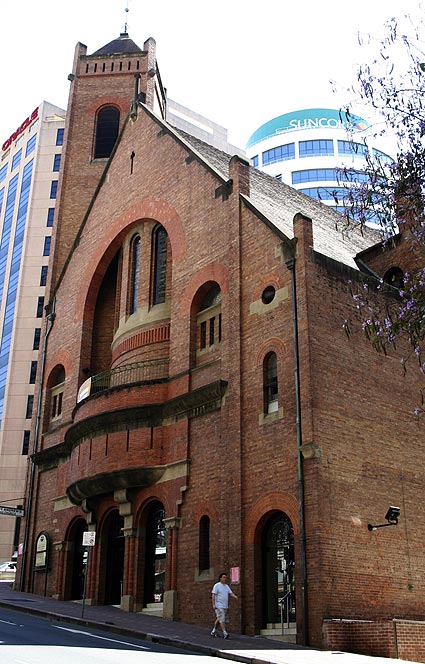
[Photograph by Trevor Bunning (October 2007)]

[Photograph by Trevor Bunning (October 2007)]
Historical and Technical Documentation by Geoffrey Cox
© OHTA 1989, 2011, 2021 (last updated January 2021)
Opened in August 1905, St Andrew's Church was built as the new home of the Presbyterian congregation that had been established in Brisbane in 1862 by the Rev. James Love. They had worshipped for a time in the old School of Arts on the corner of Creek and Queen Streets, and then successively in two buildings on Wickham Terrace.1
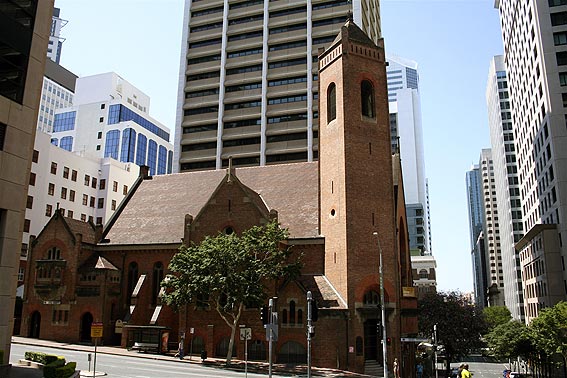
[Photograph by Trevor Bunning (October 2007)]
The new brick building on the corner of Creek and Ann Streets was designed by the innovative architect, George D. Payne, showing strong early Christian, Romanesque and Byzantine influences, and departing from the usual Gothic style of churches at the time.2
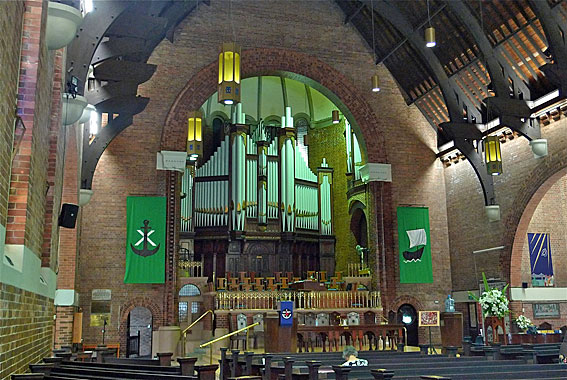
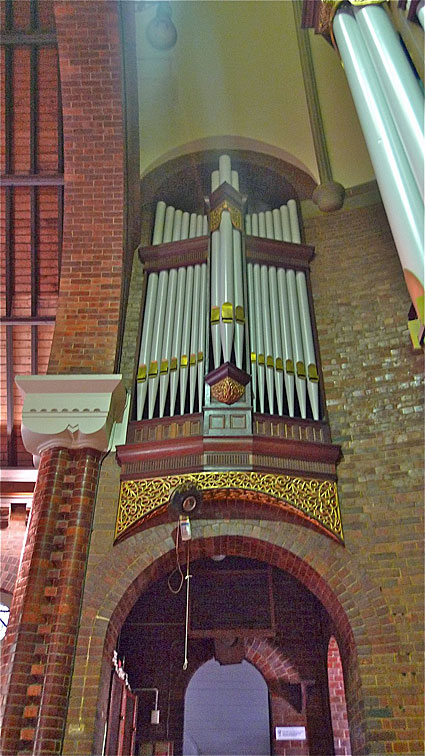
[Photographs by Trevor Bunning (November 2011)]
Negotiations for building the organ had begun early in 1903, and a tender from the Sydney builder Walter G. Rendall (trading as Austral Organ Works) was accepted in October that year. Rendall failed to complete the organ in the agreed time, however, and a small pipe organ had to be hired in 1905 from Paling & Co. as a temporary measure.3 Rendall's organ was nevertheless essentially in place when the church was opened on Sunday 27 August 1905. A description and photograph of the instrument appeared in The Brisbane Courier on the previous day, including a complete specification:
DESCRIPTION OF THE ORGAN
Church organ building has undergone many changes since the first introduction: it is of a very intricate nature. The progress of technical invention has been so rapid with the adoption of entirely new principles within the last twenty five years, that the construction of a modern organ demands the exercise of the highest scientific attainments. An organ of any musical dimensions, is necessarily of such variety and multiplicity of parts, requiring to be made conformable to the structural needs of every individual building, that the work of construction and erection require the practice of much patience and the expenditure of much time and money. It is to the credit of Australia that the St Andrew's new organ has been entirely manufactured and put together within the Commonwealth and is one of the most up-to-date on this side of the line. The contract was entrusted to the Austral Organ Works of Sydney, Mr W. G. Rendall, principal. Messrs Baker and Ladegast, of London and Leipzig have been the skilled experts under whose care the work has been largely done on the spot, the ladies' parlour and the church itself having been converted into an organ manufactory.
The case of the instrument, in silky oak, from the design of the architect, has been put together by Messrs J. D. Campbell and Sons, of this city.
There are several important features that have been adopted for the first time in Australia. The old draw stop arrangements, with its familiar rows of knobs that so tried the energies of the player and often required the manipulation of an assistant as many of us remember in the recitals in the Sydney Town Hall when Weigand was the exponent, have been superseded by "stop keys" in the ingenious form of an additional manual on the console. These particular keys, which are extremely sensitive to the touch, form the highest range, the choir, swell, and great organ, following below in order, with the combination pistons and couplers arranged above and below and between the manuals in such close proximity that the organist need never raise his hands from the keys.
The latest development is in the motoring direction. After the "passing hence" of the primitive hand-power, gas, steam, hydraulic, all found more or less wanting, we have now another power, the electric. The "Kinetic" electric blower in St Andrew's is the first installation in Australia. It is gradually replacing all other methods in England, having been approved by the Royal College of Organists, and it will be adopted shortly for the Town Hall organ in Sydney, which has undergone many alterations. The blower is rotary in its action, combining a series of induct fans, working up to any number of revolutions or power required to preserve its silent character – in the present instance 930 per minute – driven by a 3-1/2 horse-power electric motor, producing 1200 cubic feet of compressed air per minute.
The organist is no longer the man of impotence he was, when his blower peradventure might dream, sleep, or get cranky: he has become his own blower, and has but to switch on the current at his hand and individually to govern his entire instrument as well as his choir, as by the detached console he has all his singers in view and under control.
There are four manuals, or keyboards – great organ, swell, and choir organ, the fourth, or upper manual, being devoted to stop-keys, as already explained; and in addition there is the usual independent pedal organ. The organ has also seven couplers and eighteen combination pneumatic pistons, all contained in a polished silky oak case, or what is familiarly known in modern organs as the "console." The stops, embracing the couplers, are thirty-eight in number; thirty-one sounding stops grouped in the usual manner, according to volume, power, sonority, and character of tone. The swell enclosed in a chamber with louver shutters to produce the special effects of that organ. It is controlled at will by a pneumatic balance pedal.
Each sounding stop consists of 58 notes (30 on the pedal), corresponding with the number of notes on the keyboard. Altogether there are 1656 single-tone producing pipes: 1370 are of the finest spotted metal, imported from the best London and German makers; 132 of zinc, and 154 of wood. The largest and heavy zinc front case pipes were manufactured at the Sydney works, finished and lacquered in the church.
It may here be explained for the benefit of the non-professional that the diapasons are the fundamental exclusive organ stops that are without parallel in the musical sense, while the other stops are more or less imitations of orchestral instruments, or at least bear a resemblance in the nuance of tone to the designated name.
The following is the complete specification of stops:-
GREAT ORGAN
1. Double open diapason
2. Open diapason
3. Stopped diapason claribel
4. Keraulophon
5. Principal
6. Twelfth
7. Fifteenth
8. Trumpet
SWELL ORGAN
1. Lieblich Gedacht
2. Open diapason
3. Stopped diapason
4. Viola di Gamba
5. Voix Celeste
6. Harmonic flute
7. Piccolo
8. Mixture
9. Cornopean
10. Oboe
11. Vox humana
12. Tremulant
CHOIR ORGAN
1. Open diapason
2. Rohr Gedacht
3. Viol d'orchestra
4. Lieblich flute
5. Flautino
6. Clarionet
PEDAL ORGAN
1. Open diapason
2. Violone
3. Bourdon
4. Violoncello
5. Contra Fagotto
16ft.
8ft.
8ft.
8ft.
4ft.
2-2/3ft.
2ft.
8ft.
16ft
8ft
8ft
8ft
8ft
4ft
2ft
2 ranks
8ft
8ft
8ft
8ft
8ft
8ft
4ft
2ft
8ft
16ft
16ft
16ft
8ft
16ft
metal
metal
wood
metal
metal
metal
metal
metal
(CC to A3 in Alt.)
wood and metal
metal
wood and metal
metal metecholic
metal
metal
metal
metal
metal
metal
(CC to A3 in Alt.)
metal
wood and metal
metal metecholic
metal
metal
metal
(CCC to Tenor F)
wood and meta
wood and meta
full scale wood
wood and metal
The action throughout is compound tubular pneumatic, which has rendered the old fashioned tracker action obsolete.
The sound boards or windchests are membraneous, a 3in. wind pressure operating on the one side, and a 6in. on the other side of the membrane, to admit or shut off to the feet of speaking pipes, governed in turn by a system of valves, representing in combination with the keys, what is known as the 'action.' The circulation, or connection of compressed air analogous to the arterial circulation of the human anatomy, is conveyed by an apparently endless reticulation of special tubing.
The mechanism of the organ deserves a passing reference: it is here where success or failure operates. While to the uninitiated so complex, it is clear in principle, and in reality designed to reduce the working and combination to the simplest forms and limit.
The couplers are:- 1, swell to great; 2, great to suboctave; 3, swell to pedal; 4, great to pedal; 5, choir to great; 6, choir to pedal; 7, swell to choir.
They serve to combine or put into conjunction the keyboards in a varied manner: for instance, when swell to great is applied the organist is enabled by playing on the great organ manual to sound all or certain stops of the swell organ. Swell to great sub-octave sounds all music played on the great organ, an octave lower on the swell organ. Great organ to pedal attaches the thirty lowest notes of the great organ to the pedal key and so forth.
The combination pistons act singly; there are six for the swell, each button by pressing brings instantaneously into play a certain group of stops, graduated to volume of tone to impart the musical crescendo or diminuendo, or an instantaneous change from full swell to a combination, say, vox humana and stopped diapason. Four similar pistons act on the great and pedal organs combined; three on the choir, and four on the pedals only. There is also one piston which brings all sounding stops into play, and one which operates on the tremulant.
It will be seen by thirty-one sounding stops, seven couplers, and eighteen combination pistons, the possibilities of change in tone, volume and tone colour are practically endless. An immense task is set to the organ builder to make them all thoroughly effective and unfailingly respond to the instant touch of the gifted player.4
From this description it is clear that the organ case, of silky oak, was designed by the architect. In addition to the main case, there are two sets of non-speaking façade pipes in galleries on each side of the organ.
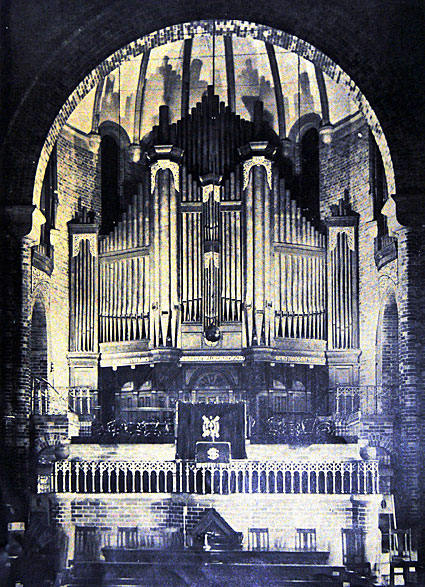
[Photograph from Uniting Church Archives, Elsternwick, Vic. (undated),
supplied to John Maidment (2006)]
Some of the innovations claimed in the above report are not supported by fact. First, the 'Kinetic' electric blower was not the first of its kind in Australia, as Fincham was already using electric blowing by this time. Secondly, the use of stop-keys was not the first in Australia: J.E. Dodd's console of 1901 at the Elder Hall, Adelaide, had stop keys.5
Rendall is known to have been using 'pneumatic and electric' action(s) elsewhere at the time,6 but the 1905 description of the St Andrew's instrument (above) states specifically that the action was 'compound tubular pneumatic,' that the swell shutters were controlled by a 'pneumatic balance pedal,' and that there were 'combination pneumatic pistons.' Earlier speculation by the present author that the instrument may have used electro-pneumatic action can now be withdrawn.7
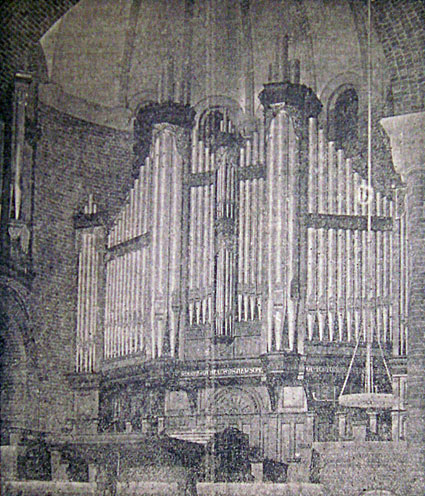
The W.G. Rendall organ of 1905
showing Rendall's detached stop-key console
[Photograph: The Daily Mail (10 March 1906), p. 13]
Some of the 1905 description was published again in The Daily Mail in March 1906, including the fact that the organ had '31 sounding stops,'8 but it is clear from the complete 1905 account that these included the Swell tremulant. There were clearly 30 speaking stops. As Simon Pierce has observed that some of the pipework in the organ dates from much earlier than 1905, it appears that Rendall's organ incorporated parts of an earlier instrument.9 It is possible, indeed, that it may contain pipework from the two-manual Gray & Davison organ of c.1855 that Rendall acquired in 1902 from the Pitt Street Congregational Church, Sydney, the subsequent history of which has never been traced.10
Not long after Rendall's organ had been installed, it was reported to be in an unsatisfactory state. The Building Committee was forced in the latter part of 1906 to call in B.B. Whitehouse & Co. to rectify the situation, and by February 1908, the organ had been completely rebuilt by B.B. Whitehouse & Co. of Brisbane. Whitehouse used an improved tubular-pneumatic action, and added a further Open Diapason 8ft stop and new zinc basses to the Great stops.11 He ordered the console, soundboards and additional front pipes for this work in 1907 from Messrs Norman & Beard, London, at a cost of £211 (job number 0848),12 and this job number was noted on the soundboards and stop-action at the time of the last major rebuild in the 1980s.13 The new console was placed adjacent to the case at this time.
Rendall was described as having become insolvent, and his contract with St Andrew's was cancelled. 'Spare material' from his instrument became the property of the Whitehouse firm, who incorporated some of it into their new instrument for West End Methodist Church in 1909.14 It can be deduced, however, from subsequent documentation (see below) that most of Rendall's pipework remained at St Andrew's, although, as will be seen, a few apparent changes (perhaps in 1922 or 1935?) are not documented.
After 1908, the first major documented alterations to the organ at St Andrew's came in 1922, when it was enlarged by Whitehouse Bros of Brisbane at a cost of £550.15 The changes at this time included a new Choir box to house the Vox Humana 8ft (formerly in the Swell) and Clarinet 8ft, borrowing of the Swell Cornopean 8ft to make a Double Trumpet 16ft [TC], and the addition of a Swell Clarion 4ft, Choir Bourdon 16ft and Tuba 8ft, Great Mixture III, Pedal Acoustic Bass 32ft, and Swell Super and Sub couplers.16
In September 1935, the instrument was cleaned and overhauled by Whitehouse Bros, and the console was moved to the front of the choir gallery.17 This was still presumably the Norman & Beard console that had been supplied in 1908. A description of the work undertaken in 1935 was published in The Telegraph as follows:
ST. ANDREW'S ORGAN IMPROVED
Successive improvements have made the organ at St, Andrew's Presbyterian Church one of the finest church instruments in the Commonwealth. Following the latest innovation of moving the console to give the organist better control, a recital to celebrate the re-opening of the organ will be given next Monday at 8 p.m. by the church organist (Mr. Herbert Cannon, A.R.C.O.), assisted by leading artists.
. . . The instrument has now been cleaned and overhauled and the console moved a further seven feet from the face of the main organ. This will give the organist better control of his choir. The choir gallery has been reconstructed to allow of a more convenient arrangement of the choir members. The whole of the work has been carried out by Whitehouse Bros.18
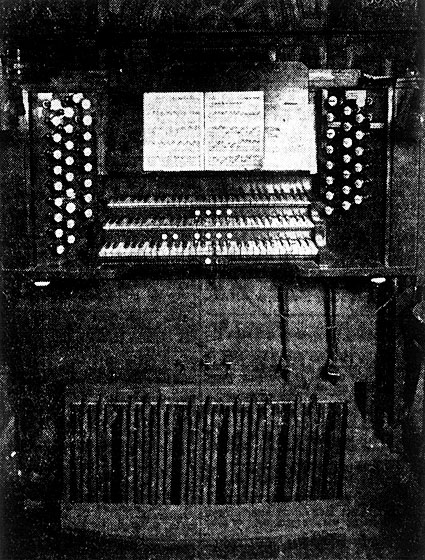
The 1908 console, detached in 1935
[Photograph: The Telegraph (26 September 1935), p. 19]
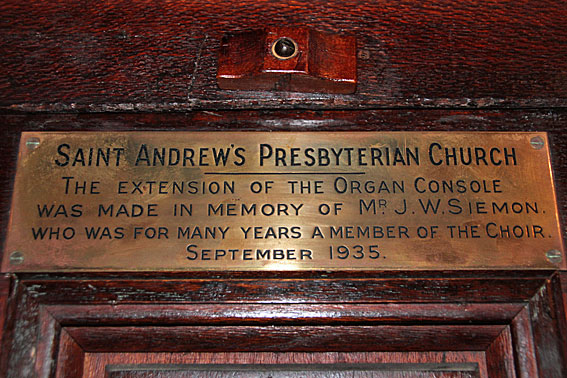
Plaque marking the detaching of the console in 1935
[Photograph by Steven Nisbet (June 2012]
In 1941 the action was converted to electro-pneumatic by Whitehouse Bros, and yet another console (the third in succession) was installed. The instrument was re-opened and re-dedicated on Sunday 2 November.19 In 1959 a Choir Orchestral Oboe 8ft was added by J.W. Walker & Sons in place of the former Vox Humana 8ft, which was placed in storage at the church.20 By this time, the organ had 38 stops and 11 couplers, and it remained in this form until the early 1980s:
| GREAT Double Diapason Open Diapason No 1 Open Diapason No 2 Clarabella Keraulophon Principal Harmonic Flute Fifteenth Mixture Trumpet SWELL Bourdon Violin Diapason Viol da Gamba Vox Celestes Lieblich Gedact Gemshorn Harmonic Flute Piccolo Mixture Oboe Double Trumpet [Ten.C.] Cornopean Clarion CHOIR (partly enclosed) Bourdon Open Diapason Rohr Gedact Dulciana Lieblich Flute Flautina Orchestral Oboe Clarinet Tuba PEDAL Acoustic Bass Open Diapason Violone Bourdon Violoncello Contra Fagotto COUPLERS Swell Sub Octave Swell Super Octave Swell to Great Super Swell to Great Sub Swell to Pedal 4' Swell to Great Choir to Great Swell to Choir Swell to Pedal Great to Pedal Choir to Pedal |
16 8 8 8 8 4 4 2 III 8 16 8 8 8 8 4 4 2 II 8 16 8 4 16 8 8 8 4 2 8 8 8 32 16 16 16 8 16 |
A A A |
[1908] [1922 or 1935?] [1922] [1922 or 1935?] [1922] [1922] [1922] [1922 or 1935?; former Viol d'orchestra (1905)?] [1959; formerly Sw Vox Humana (1905)] [1922] [1922] [1922] [1922] [1922] [1922] |
Swell tremulant
Choir tremulant
Solo tremulant (enclosed shops)
5 thumb & toe pistons to Swell Organ
5 thumb & toe pistons to Great Organ
4 thumb pistons to Choir Organ
Balanced Swell Pedal
Balanced Choir Pedal
General crescendo pedal
Radiating concave pedalboard.21

[Photograph by Mark Quarmby (November 1985)]
In 1983-84 the organ was rebuilt by J.W. Walker & Sons (Australia) Pty Ltd.22 A new console (the fourth in less than a century) was supplied, and the specification was redesigned. In order to allow all of the existing and new pipework to be accommodated on the existing chests, three of the existing stops were removed: Choir Open Diapason 8ft and Flautina 2ft (1905) and the Choir Tuba 8ft (1922). The latter was purchased by The Southport School.23 The rebuilt organ was dedicated on Sunday 8 July 1984, and the opening recital was given on Saturday 28 July 1984 by Steven Nisbet, with associate artist Margaret Russell, mezzo soprano.24

The 1984 console supplied by J.W. Walker & Sons
[Photograph by Howard Baker (1990s)]
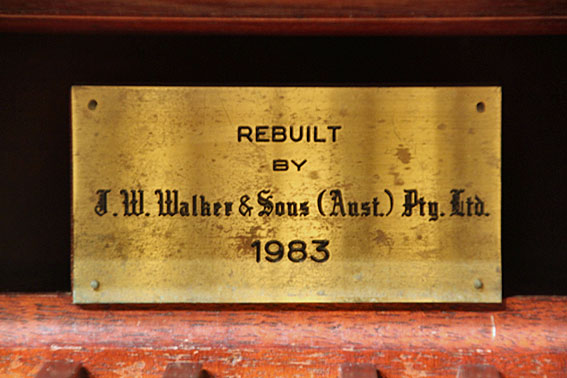
1983 plaque on the J.W. Walker & Sons console
[Photograph by Steven Nisbet (June 2012)]
Since the completion of the organ in its present form, a new Solid State Logic capture system was supplied in 1998, including the addition of 8 general combination pistons. At the time of renovations to the interior of the church building in 2000, the console was rotated ninety degrees and moved off-centre to allow for the choir conductor to occupy a central position.25
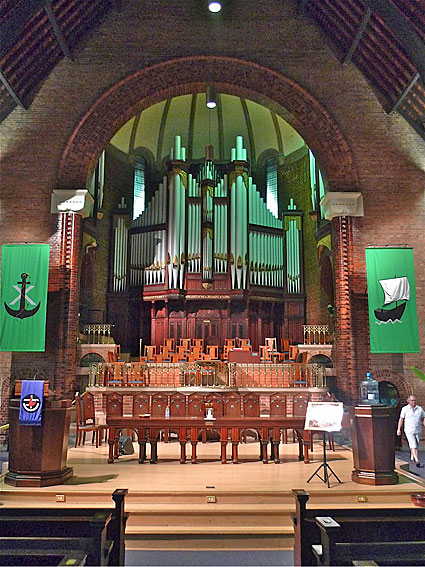

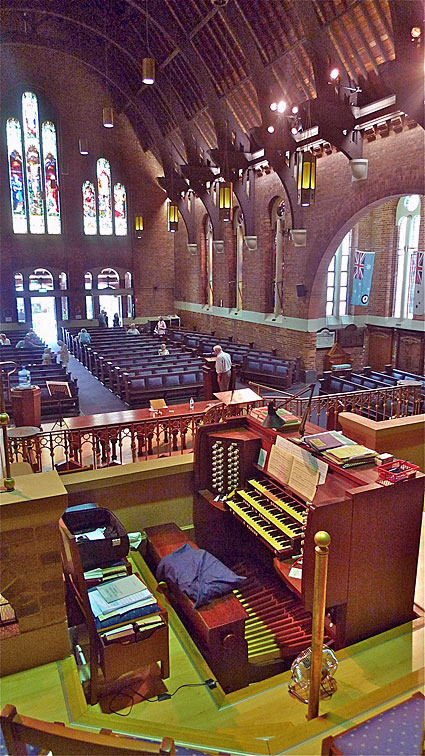
The re-ordered church interior
with the organ console facing across the gallery
[Photographs by Trevor Bunning (November 2011)]
In July-August 2019, the organ was cleaned by Pierce Pipe Organs. Minor repairs to the winding system were undertaken at the same time.26
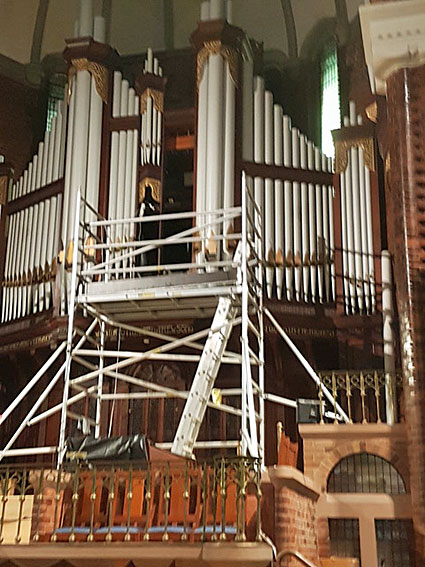
The organ during cleaning and repairs in July-August 2019
[Photograph by Steven Nisbet]
The current specification of 40 speaking stops is as follows:
| GREAT Double Diapason Open Diapason Clarabella Principal Wald Flute Twelfth Fifteenth Fourniture Trumpet SWELL Bourdon Violin Diapason Viola da Gamba Voix Celeste Lieblich Gedackt Octave Harmonic Flute Piccolo Mixture Cornopean Oboe Clarion CHOIR (unenclosed) Rohr Gedackt Lieblich Flute Nazard Principal Tierce Clarinet Orchestral Trumpet PEDAL Acoustic Bass Open Diapason Violone Bourdon Principal Violoncello Bass Flute Fifteenth Flute Mixture Contra Fagotto Schalmei COUPLERS Swell Sub Octave Swell Super Octave Swell Unison Off Swell to Great Choir to Great Swell to Choir Swell to Pedal Great to Pedal Choir to Pedal |
16 8 8 4 4 2-2/3 2 IV 8 16 8 8 8 8 4 4 2 III 8 8 4 8 4 2-2/3 2 1-3/5 8 8 32 16 16 16 8 8 8 4 4 III 16 4 |
A B A B |
[No 2 Open Diapason 8 (1905)] [Harmonic Flute 4 (1922 or 1935?)] [Keraulophon 8 (1905)] [1984] [renamed Gemshorn 4 (1922 or 1935?)] [formerly II] [1922] [1984] [1984] [Ch Dulciana 8 (1922 or 1935?); Viol d'orchestra (1905)?] [returned to main chest] [1984] [1922] [Gt No 1 Open Diapason 8 (1908)] [Ch Bourdon 16 (1922)] [Gt Mixture III (1922) & Ch Open Diapason 8 (1905)] [Sw Vox Humana (1905); Ch Orchestral Oboe 8 (1959)] |
Swell tremulant
Choir tremulant
Compass: 58/30
6 thumb pistons to Swell Organ
6 thumb pistons to Great Organ
4 thumb pistons to Choir Organ
6 toe pistons to Pedal Organ
8 general combination pistons [1998]
Solid State Logic capture system [1998]
Balanced swell pedal (mechanical).27
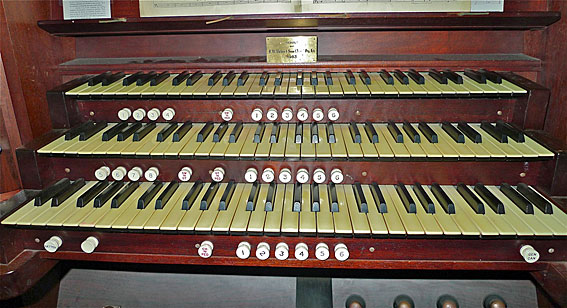
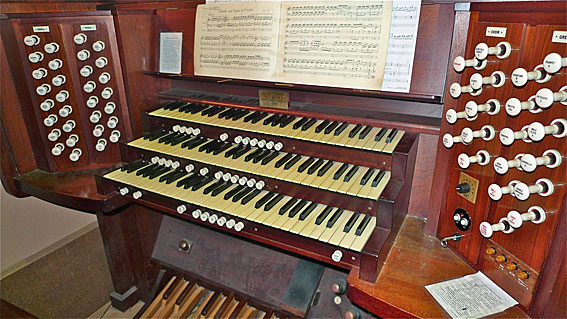


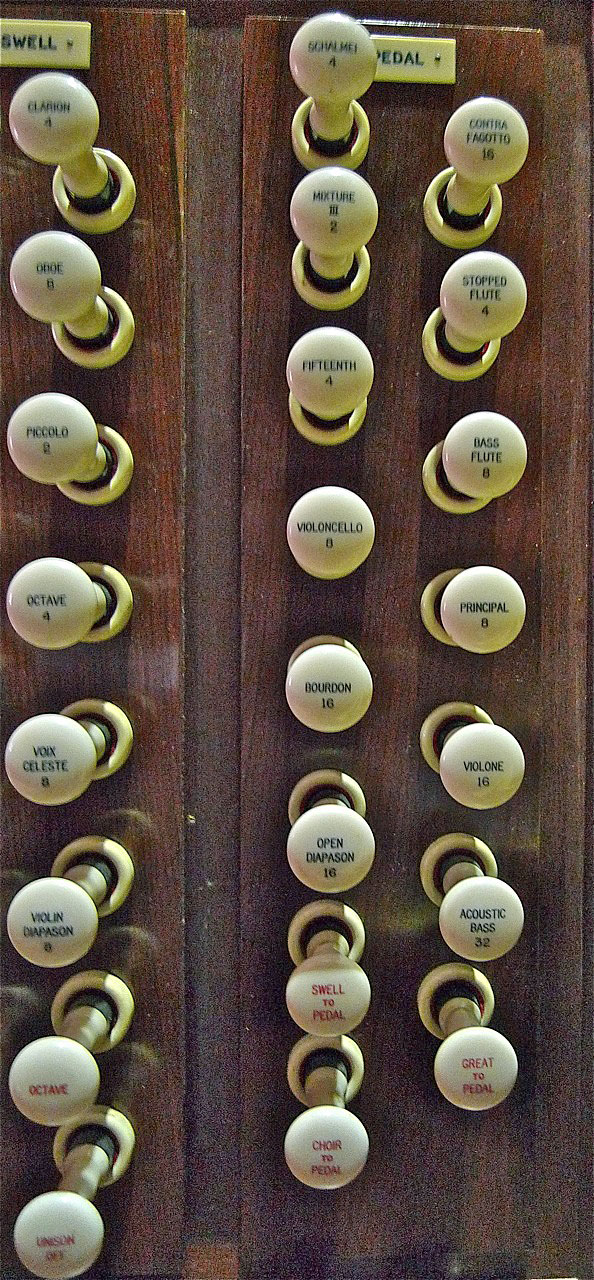
Details of the J.W. Walker console
[Photographs by Trevor Bunning (November 2011)]
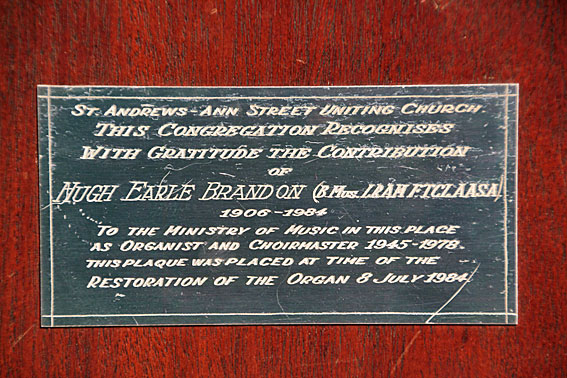
Plaque commemorating the ministry of Hugh Earle Brandon
as Organist and Choirmaster at St Andrew's (1906-1984)
[Photograph by Steven Nisbet (June 2012)]
______________________________________________________________________________
1 Richard Bardon, The Centenary History of The Presbyterian Church of Queensland (Brisbane: W. R. Smith & Paterson, 1949), pp. 218-19; The Brisbane Courier (14 October 1902), p. 7; The Brisbane Courier (26 August 1905), pp. 4, 12.
2 Queensland Heritage Council, Queensland Heritage Register, location 600086.
3 Minutes of the Building Committee of St Andrew's Church (10 November and 17 December 1903), cited by the late Hugh Brandon (organist 1945-1978).
4 The Brisbane Courier (26 August 1905), pp. 12-13.
5 Observations by John Maidment, August 2014.
6 W. G. Rendall, 'Letter to Editor,' Musical Opinion & Music Trade Review, vol. 27 (1903), pp. 129-30; reprinted in Graeme D. Rushworth, Historic Organs of New South Wales (Sydney: Hale & Iremonger, 1988), p. 143.
7 Geoffrey Cox, Gazetteer of Queensland Pipe Organs (Melbourne: Society of Organists (Vic) Inc., 1976), p. 3.
8 The Daily Mail (10 March 1906), p. 9.
9 Noted by W.J. Simon Pierce at the time of the 1983-84 rebuild.
10 Rushworth, op. cit., pp. 144, 254-56.
11 Minutes of the Building Committee (1906-1908), op. cit.; The Telegraph (26 September 1935), p. 19; The Brisbane Courier (27 September 1935), p. 15.
12 Norman & Beard Order Book 1907, vol. 11, p. 120; cited on the archives website of the British Institute of Organ Studies by John Maidment, May 2002.
13 Noted by W.J. Simon Pierce in OHTA News, vol. 7, no. 4 (October 1983), p. 27.
14 This instrument is now at Holy Trinity Anglican Church, Fortitude Valley.
15 Whitehouse Bros Ledger (1922-1940), p. 121 describes the work undertaken as "rebuilding".
16 Details supplied Steven Nisbet (organist since 1979).
17 Whitehouse Bros Ledger (1922-1940), p. 578.
18 The Telegraph (26 September 1935), p. 19; see also The Brisbane Courier (27 September 1935), p. 15.
19 Whitehouse Bros Ledger (1940-1954), p. 315; The Courier-Mail (1 November 1941), p. 5.
20 Personal communication to G. Cox from Hugh Brandon, c.1973; date supplied by Steven Nisbet.
21 Collected Organ Specifications of Bernie Brohan (c.1952) and Edward R. Salisbury (n.d.).
22 The Telegraph (26 July 1984).
23 Personal communication to G. Cox from Steven Nisbet, 1989.
24 S. Nisbet, 'The Organ in St Andrew's Uniting Church, Brisbane,' The Organ Voice, vol. 19, no. 2 (October 1991), p. 11.
25 The Organ Voice, vol. 31, no. 2 (June 2004), p. 7; Dates and details supplied by Steven Nisbet.
26 Personal communication to G. Cox from Steven Nisbet, January 2021
27 Proposed specification from J.W. Walker & Sons, supplied by David Vann, 1982; further details supplied by Steven Nisbet, 1989, and from S. Nisbet, 'The Organ in St Andrew's Uniting Church, Brisbane,' op. cit., pp. 8-14.